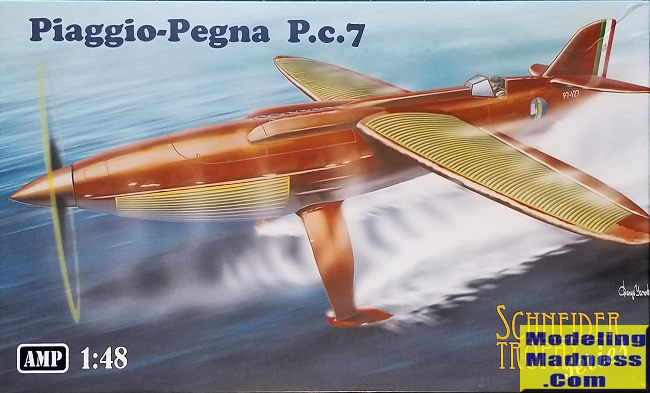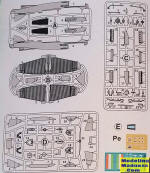
AMP 1/48 Piaggio-Pena P.C.7
| KIT #: | 48011 |
| PRICE: | $65.00 |
| DECALS: | One option |
| REVIEWER: | John Summerford |
| NOTES: |

| HISTORY |
This information is courtesy of Wikipedia.
“The Piaggio P.7, also known as the Piaggio-Pegna P.c.7, was an Italian racing seaplane designed and built by Piaggio for the 1929 Schneider Trophy race.
“Seeking to avoid the aerodynamic drag induced by floats in seaplanes of floatplane design, Ing Giovanni Pegna of the Piaggio company designed a very unusual seaplane to represent Italy in the 1929 Schneider Trophy race. A cantilever shoulder-wing monoplane, known both as the Piaggio P.7 and the Piaggio-Pegna P.c.7, his design floated up to its wings on its long, slender, watertight fuselage with the wings resting on the water, and employed twin high-incidence hydrofoils to get itself off the water during takeoff runs.
“Sources differ on the P.7's engine; it is described both as an Isotta Fraschini Special V6 rated at 723 kW (983 PS; 970 hp) and as an Isotta Fraschini AS-5 of 745 kW (1,013 PS; 999 hp). The engine was connected both to a two-bladed automatic variable-pitch tractor propeller by a long metal shaft and by another shaft to a smaller marine propeller, similar to those used on motorboats, mounted beneath the aircraft's tail. To take off, the pilot would start the engine with the flight propeller feathered and the normal carburetor air intake closed and use a clutch to engage the tail propeller and get the aircraft moving through the water. The two hydrofoils, mounted beneath the fuselage on struts just forward of the wings similar to the way in which floats were mounted on floatplanes, would cause the P.7 to rise out of the water almost immediately. After the aircraft had risen on its hydrofoils and the flight propeller had cleared the water, the pilot would open the carburetor air intake, again employing the clutch to disengage the marine propeller, and use another clutch to engage the flight propeller, which automatically would switch from feathered to flight pitch. Driven by its flight propeller, the aircraft then would engage in a conventional takeoff, riding on its submerged hydrofoils until it reached takeoff speed.
“Without the aerodynamic drag induced by floats or the weight they added to the aircraft, Pegna projected that the P.7 would reach high speeds. Sources differ on the speeds he predicted, claiming both 580 km/h (360 mph) and 700 km/h (434.7 mph).
“Piaggio manufactured one P.7 and turned it over to the Italian Schneider Trophy racing team. Although some pilots refused to fly the aircraft, the Italian Schneider team's Tommaso dal Molin conducted some water tests on Lake Garda in northern Italy. The spray the hydroplanes generated made it difficult to see during takeoff, and persistent problems with both clutches ensued. The aircraft never became airborne.
“Not ready in time, the P.7 was excluded from the 1929 Schneider Trophy race, in which a Macchi M.52R and two Macchi M.67 seaplanes represented Italy. Piaggio and Pegna abandoned plans to build a second P.7.”
| THE KIT |
 Inside
the box are four gray plastic sprues, one clear wind screen plus vinyl masks, a
small fret of photo-etch parts consisting of seatbelts and instrument panel, and
a small sheet of decals. The sprues are held in one zip top ba
Inside
the box are four gray plastic sprues, one clear wind screen plus vinyl masks, a
small fret of photo-etch parts consisting of seatbelts and instrument panel, and
a small sheet of decals. The sprues are held in one zip top ba g
and the other components in another. There are 66 parts on the sprues and they
have good detail. Gates to the parts are on the heavy side. The decals are for
the single airframe.
g
and the other components in another. There are 66 parts on the sprues and they
have good detail. Gates to the parts are on the heavy side. The decals are for
the single airframe.
Instructions extend over five pages and comprise 16 steps of typical sequence. Color call-outs are for Mr. color paints and include printed swaths with basic names.
| CONCLUSIONS |
For a design some 90 years old, this aircraft looks futuristic, or perhaps something seen in an anime show. Too bad it never flew. I like the creativity of the concept. This kit looks to be a slow, but straight forward build with constant filing and test fitting needed along the way. My understanding is that this is the first of a series of Schneider racers. I hope AMP Kits will produce Jimmy Doolittle’s R3C-2.
October 2019
Copyright ModelingMadness.com. If you would like your product reviewed fairly and fairly quickly, please
contact
the editor or see other details in the
Note to
Contributors. Back to the Main Page
Back to the Review
Index Page
Back to the Previews Index Page